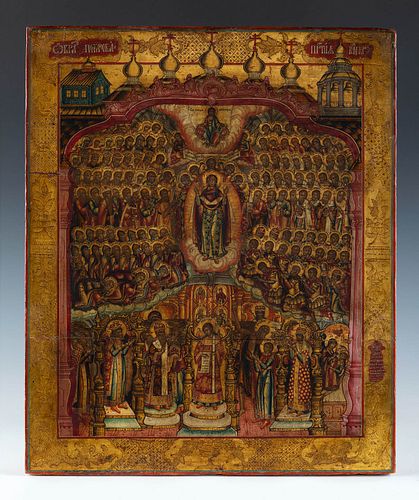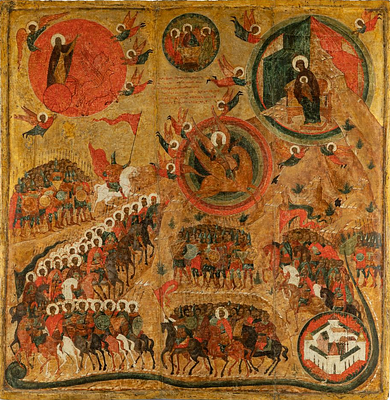School of the Orthodox Old Believers of Vetka, 18th century. "The Protection of the Mother of God", or "The Virgin of Pokrov". Tempera and gold leaf o
Lot 26
About Seller
Setdart Auction House
Carrer Aragó 346
Barcelona
Spain
Setdart Subastas was born in 2004 and is currently the first online art auction in Spain with solidity, prestige and reliability guaranteed by our more than 60,000 users. Setdart has a young, dynamic and enterprising team ready to successfully manage the purchase and sale of art works through custom...Read more
Estimate:
EUR€5,000 - EUR€6,000
$5,208.33 - $6,250
Absentee vs Live bid
Two ways to bid:
- Leave a max absentee bid and the platform will bid on your behalf up to your maximum bid during the live auction.
- Bid live during the auction and your bids will be submitted real-time to the auctioneer.
Bid Increments
| Price | Bid Increment |
|---|---|
| EUR€0 | EUR€10 |
| EUR€200 | EUR€25 |
| EUR€500 | EUR€50 |
| EUR€1,000 | EUR€100 |
| EUR€3,000 | EUR€200 |
| EUR€5,000 | EUR€500 |
| EUR€10,000 | EUR€1,000 |
| EUR€20,000 | EUR€2,000 |
| EUR€50,000 | EUR€5,000 |
About Auction
By Setdart Auction House
Sep 23, 2021
Set Reminder
2021-09-23 10:00:00
2021-09-23 10:00:00
America/New_York
Bidsquare
Bidsquare : RUSSIAN ICONS
https://www.bidsquare.com/auctions/setdart-auction-house/russian-icons-7431
Setdart Auction House sofia@setdart.com
Setdart Auction House sofia@setdart.com
- Lot Description
School of the Orthodox Old Believers of Vetka, 18th century. "The Protection of the Mother of God", or "The Virgin of Pokrov". Tempera and gold leaf on carved panel. Measurements: 53.5 x 44.5 cm. "The Virgin of Pokrov" is one of the iconographies typical of the Russian Orthodox Church, although it describes events that took place in Constantinople around the year 910. The story was originally taken from the biography of Andrew of Constantinople, who, together with his disciple Epiphanius, saw the Mother of God flying over the Church of St Mary of Blanquernas, covering the believers with her omophorion as a symbol of protection. On several occasions the story was modified, the last being the version of Bishop Demetrius of Rostov, composed towards the end of the 17th century, who said that among those who saw the miracle were John the Baptist, John the Apostle, Andrew of Constantinople, and King Leo the Wise. The significance of this miracle is that the Mother of God protected the city of Constantinople against the Muslim invasion. The prototype of the icon of the protection of the Mother of God, or, in Russian, Pokrov, developed around the 14th century, although it became more widespread in later centuries. Its iconography can be easily distinguished by the cathedral with five domes in the background, and the figure of the Virgin Mary always located in the central register of the icon, with St John the Baptist and Andrew of Constantinople in the lower register on both sides, indicating the appearance of the Virgin with their index fingers. On this basis, two main typologies can be distinguished, that of the Novgorod school, and that of the Rostov-Suzdal school, which was eventually absorbed by the Moscow school around the 17th century. In the case of the lot we are interested in, it can be deduced that we are dealing with an icon from the Moscow school, influenced by the painters of Rostov and Suzadal, due to the presence of the character typical of the Rostov school, Roman the Méloda, the author of several songs dedicated to the Virgin Mary. In chronological terms, the icon belongs to a period towards the end of the 18th century, as is indicated by the darker colour range, with an evident abundance of brown and greenish tones, the architectural elements, as well as the painter's knowledge of perspective, which can be seen in the lower register of the icon. This icon has several curious features, which show that it most probably belongs to the workshops of the Old Believers. Firstly, the carved border. Secondly, the iconographic scene, like the saints, is accompanied by numerous inscriptions. Thirdly, the letters 'ICXC', visible in the upper register, are an abbreviation of the Greek for the name of Jesus Christ. Finally, the crosses that decorate the domes have eight dots, and the fingers of the saints show the blessing with two fingers, features typical of the icons of the Old Believers. The Old Believers were a group of the Orthodox who, after Nikon's church reforms of 1654, decided to follow their opponent Avvakum, defending the traditional foundations of the Orthodox Church. Fleeing persecution, they settled in the villages of Pomorie, near the Urals and in Siberia, although by the 18th century they began to settle in the northern areas near Moscow. The Old Believers' Faith was legalised as early as 1905, which sparked an interest in the Russian Empire in the discovery of the national religious heritage, as well as the development of collecting ancient icons, which had never been experienced before.
- Shipping Info
-
In-house shipping available. Please inquire at admin@setdart.com.
-
- Buyer's Premium



 EUR
EUR CAD
CAD AUD
AUD GBP
GBP MXN
MXN HKD
HKD CNY
CNY MYR
MYR SEK
SEK SGD
SGD CHF
CHF THB
THB
















